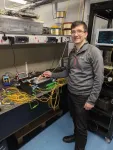(Press-News.org)
Although you may not always realize it, many of the jobs you do can put strain on, and even cause damage to, your nerves.
Sandra Hearn, M.D., the associate chair of Education and Professional Development in the Department of Physical Medicine and Rehabilitation, and a team of collaborators, set out to better understand the causes of occupational nerve injuries.
What is an occupational nerve injury?
An occupational nerve injury refers to a problem with your peripheral nerves that's caused by a work-related activity. It's often seen in manual labor jobs.
Hearn and her team conducted a review that focused specifically on the injuries that occur over time through repetitive motion.
“While some injuries involve unpredictable accidents, like having a limb crushed in machinery or having a vehicle accident at work, we looked at more predictable mechanisms that can injure nerves where they are vulnerable,” Hearn said.
“These mechanisms often involve repetitive trauma with damage to the nerves over time.”
According to Hearn, nerve injuries presenting within the context of specific tasks at work give researchers information about how a common mechanism, across different individuals, can manifest in pathology.
“When we look beyond overt crush injuries or lacerations, we find that several biomechanical stressors underlie many occupational nerve injuries, regardless of which body part is affected,” she said.
“These can include compression, stretch, vibration, and repetitive or high-force movements of regional muscles and joints.”
The paper’s findings
The review found that workers whose jobs required manual labor were most likely to be at risk for an occupational nerve injury. More specifically, jobs that required repetitive movements with high force, such as lifting heavy loads, heavy hammering and repeated squatting, were at the highest of risk.
Although some of these injuries can have an abrupt onset, meaning you can pinpoint when you got hurt and when your symptoms started. But others can occur gradually over time and with continued repetition.
While some injuries involve unpredictable accidents, like having a limb crushed in machinery or having a vehicle accident at work, our review focuses on predictable mechanisms that can injure nerves where they are vulnerable.”Sandra Hearn, M.D.
“Many of these injuries present as a cumulative trauma situation, without a clear moment of injury,” said Hearn. “For example, it could be that someone has used a jackhammer for many years and starts to develop a syndrome of waking up in the morning with the hands numb.”
Hearn says one of the most surprising findings was how specific anatomic variants can predispose your nerves to a greater risk of injury.
“Where a common mechanism exists, anatomic variation can often explain why some workers experience a nerve problem and others do not,” Hearn said. “The chances of an individual becoming injured depends on how their nerves respond to the repetitive task.”
Each work-related injury is unique. That’s why Hearn and her team aimed to learn about the best way to approach the majority of these common work-related injuries so that they could create a reference guide that would work to treat as many patients as possible.
“We recognize that today, occupations and the specific tasks they require, are very diverse. Creating a list of all possible job tasks and associated nerve injuries is essentially impossible,” said Hearn.
Their goal, now instead, is to equip clinicians to recognize, when treating workers with possible nerve-related problems, where and how biomechanical factors may interact with the anatomy to damage nerves.
“This understanding can be applied even when patients describe occupations and tasks that vary from those presented in the review. It offers the community plausible diagnoses and appropriate treatments for patients with these work-related nerve injuries.”
Additional authors include Shawn P. Jorgensen M.D., Joelle M. Gabet M.D., and Gregory T. Carter, M.D.
Paper cited: “Occupational Nerve Injuries,” Muscle and Nerve. DOI: 10.1002/mus.28099
Sign up for Health Lab newsletters today. Get medical tips from top experts and learn about new scientific discoveries every week by subscribing to Health Lab’s two newsletters, Health & Wellness and Research & Innovation.
Sign up for the Health Lab Podcast: Add us on Spotify, Apple Podcasts or wherever you get you listen to your favorite shows.
END
Researchers from the Icahn School of Medicine at Mount Sinai have shed valuable light on the nuanced functions and intricate regulatory methods of RNA editing, a critical mechanism underlying brain development and disease.
In a study published June 26 in Nature Communications, the team reported finding major differences between postmortem and living prefrontal cortex brain tissues as they relate to one of the most abundant RNA modifications in the brain, known as adenosine-to-inosine (A-to-I) editing. This discovery will play a significant role ...
PHILADELPHIA— A team of researchers led by Penn Medicine will investigate the link between traumatic brain injuries (TBI) and Alzheimer’s disease and related dementias (ADRD) over the next five years with a $10 million grant from the National Institute of Neurological Disorders and Stroke (NINDS). Using an extensive tissue bank including over 1,000 samples, the researchers aim to uncover the underlying biological mechanisms of TBI-related neurodegeneration (TReND) from a variety of brain injury types. ...
Aston Institute of Photonic Research academics are part of a team that sent data at a rate of 402 terabits per second
This beats their previous record of 301 terabits per second
They constructed the first optical transmission system covering six wavelength bands.
Aston University researchers are part of a team that has sent data at a record rate of 402 terabits per second using commercially available optical fibre.
This beats their previous record, announced in March 2024, of 301 terabits or 301,000,000 megabits per second using a single, standard optical fibre.
"If compared to the internet connection speed recommendations of Netflix, of 3 Mbit/s ...
A handful of common surgical procedures account for large shares of all opioids dispensed after surgery in children and adults, according to two studies recently published by researchers at the University of Michigan.
The studies, published this week in Pediatrics and JAMA Network Open, report that the top three procedures for children ages 0-11 account for 59% of opioids dispensed after surgery (tonsillectomies and adenoidectomies 50%, upper extremity fractures 5% and removal of deep implants 4%). Among those ages 12-21, the top three procedures account for ...
Alexey Vertegel, Ph.D., Associate Professor in the Department of Bioengineering, Clemson University, has been awarded a $2.1M Small Business Innovation Research (SBIR) Phase II grant from the National Institute of Allergy and Infectious Diseases (NIAID) to develop long-lasting natural disinfectants. Currently used surface disinfectants provide high-level activity over a relatively short period of time, typically less than 4 hours. During the Phase I study, his team developed a novel film-forming disinfectant based on chitosan, alcohol, and a natural antimicrobial, which is slowly released from the ...
UPTON, N.Y. — Elke Arenholz, a renowned scientist known for her expertise in magnetic materials and X-ray spectroscopy, scattering, imaging, and instrument development, has been named director of the National Synchrotron Light Source II (NSLS-II), a U.S. Department of Energy (DOE) Office of Science user facility at DOE’s Brookhaven National Laboratory, effective August 2024.
Arenholz’s appointment comes following a search that began in summer 2023 after John Hill, the previous director of NSLS-II, ...
UNIVERSITY PARK, Pa. — A recent discovery by NASA’s James Webb Space Telescope (JWST) confirmed that luminous, very red objects previously detected in the early universe upend conventional thinking about the origins and evolution of galaxies and their supermassive black holes.
An international team, led by Penn State researchers, using the NIRSpec instrument aboard JWST as part of the RUBIES survey identified three mysterious objects in the early universe, about 600-800 million years after the Big Bang, ...
In today's interconnected world, the actions of corporations can have far-reaching consequences. A new study, co-authored by two University of Akron (UA) faculty and published in the top ranked international business journal Global Strategy Journal, reveals that incident of corporate social irresponsibility (CSI) — like pollution, corruption, discrimination, or poor labor conditions in supply chains — significantly damage brand reputation and international sales growth.
Over nine years and across 109 countries, researchers tracked the performance of 335 company branches alongside reported CSI incidents involving their parent companies. The results clearly ...
A study from Michigan Medicine's Kresge Hearing Research Institute was able to produce supranormal hearing in mice, while also supporting a hypothesis on the cause of hidden hearing loss in humans.
The researchers had previously used similar methods—increasing the amount of the neurotrophic factor neurotrophin-3 in the inner ear—to promote the recovery of auditory responses in mice that had experienced acoustic trauma, and to improve hearing in middle-aged mice.
This study is the first to use the same approach in otherwise healthy young mice to ...
Results from a national survey indicate that many Americans, 61%, are unaware that primary care physicians can prescribe medications for opioid use disorder, and 13% incorrectly believed that they could not. The survey, funded by the National Institutes of Health (NIH), also found that 82% of the people who reported ever misusing prescription or illicit opioids expressed comfort in going to their primary care physicians for medications for opioid use disorder. Among those who had not misused opioids, a majority, 74%, reported they would ...



